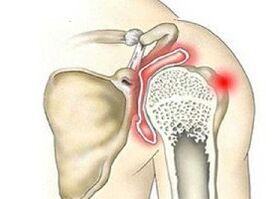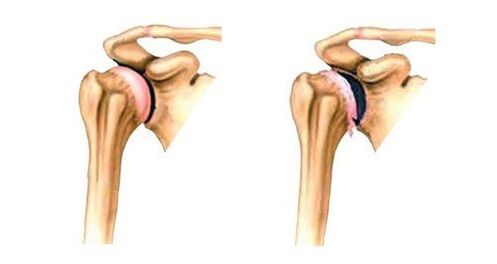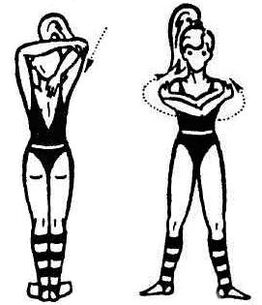
Well -known to many people, mostly the elderly, is joint pain. It is caused by malnutrition, lack of physical activity, stress, heavy physical effort and other factors.
Often, in the elderly and in a small percentage of young people, osteoarthritis of the shoulder joint occurs - a chronic disease that causes serious deformation of cartilage, as well as adjacent tissues, and bone. It has a progressive type, and symptoms may not appear for years, and then worsen.
The most common symptoms are pain in the shoulder after a long stay at low temperatures, as well as after lifting heavy objects.
Do not self -medicate. At the first sign of illness, seek medical advice.
cause
Deforming arthrosis of the shoulder joint occurs due to an inflammatory process that develops in the hand joint. Among the main causes of the onset and progression of the disease are:
- injuries (dislocations, bruises, fractures);
- excessive physical activity (tennis players, basketball players);
- Malnutrition;
- the presence of bad habits;
- infection of the joint cups.
Arthrosis of the shoulder joint is accompanied by an inflammatory process. As a result, cartilage tissue loses its properties and becomes thinner. Also, the disease in further cases contributes to the deformation and even destruction of cartilage tissue, its growth into bone structures.
Signs of the disease
Osteoarthritis of the shoulder joint usually begins to appear in people over the age of 45, as this is associated with age -related changes in the body. An important role in symptoms is played by the profession a person belongs to, the lifestyle he or she adheres to. Lack of synovial fluid is one of the leading causes of cartilage destruction.
The symptoms of the disease can manifest themselves in different ways: usually at first there is a slight discomfort or aching pain in the shoulder if it takes a certain position. The pain when taking another position usually subsides or disappears, however, if the patient does not see a doctor to treat the early symptoms, the disease will progress. The nature of the pain felt by a person with arthrosis is pain. Sometimes they are felt on the back, elbows or all over the arms (in the first and second levels, then they get stronger).
The intensity of discomfort can be exacerbated by changes in weather conditions or the presence of constant physical exercise. The disease in the early stages will not bother the patient when the shoulder is at rest. Then, there is a limitation in the number of joint movements, which are consciously set by the patient. During this time, the cartilage of the joint is destroyed, the process of bone (osteophytes) grows, which greatly complicates the movement. In the last stage of the disease, the patient can lift his arm no higher than 90 degrees, as the cartilage merges into a bone formation, making it impossible to move the arm.
Stage of the disease
There are 4 degrees of this disease:
- Grade 1 is characterized by minor damage to cartilage tissue. Patients sometimes experience unpleasant pain after holding the shoulder for a long time in one position or lifting a heavy object. At this stage, special exercise and diet can treat the symptoms that appear and prevent further stages;
- Grade 2 is characterized by the occurrence of osteophytes, as well as narrowing of the joint space (displayed on x-ray). The pain in this case is more frequent and acute;
- Grade 3 causes a decrease in the number of hand movements. X-rays show the minimum size of the opening between the shoulder joints. The patient always feels a sharp pain that does not go away during rest;
- Grade 4 occurs if the patient does not turn to a specialist in time. At the same time, a combination of cartilage and bone processes is detected, which makes it impossible to move the hand.

Treatment
Treatment of arthrosis of the shoulder joint has several options, depending on the severity of the disease:
- prosthetic surgery;
- drug treatment;
- physiotherapy;
- medical and physical culture complex (LFK);
- traditional medicine;
- diet.
In the early stages of development, the disease can be successfully treated with steroidal and non-steroidal medications, as well as medications that relieve vascular and muscle spasms. Medications help patients relieve pain, as well as restore damaged cartilage tissue.
If the patient goes to the doctor on time, he can prescribe him a therapeutic form of gymnastics. It helps increase joint mobility. In the early stages, it is sometimes enough to do the exercises prescribed by a specialist, and then do not need surgery or take large amounts of medication.
The so-called method of surgical treatment is prescribed by a doctor if conservative methods (gymnastics, medications) do not help. The most well -known method that can cure deformed shoulder joint arthrosis is arthroplasty. At the same time, the collapsed joint will be replaced by a modern prosthesis, designed to perform all the functions of the shoulder joint. The prosthesis is designed for several years of work. Surgical intervention is used in the last stages of disease development, when it does not make sense to treat it by other methods.

Treatment of arthrosis of the shoulder joint with folk remedies, in principle, is not prohibited, but your doctor must approve it. It must also be compatible with other drugs. But don’t neglect gymnastics and other exercises. Exercise therapy can be carried out in the remission phase, and exacerbation does not include the possibility of any exercise. Wherever a patient discovers an exercise, before proceeding with it, he or she must show it to his or her doctor, who will confirm or deny their health and treatment benefits. Also contraindicated for treatment with gymnastics are fever, lung disease, heart disease and other diseases.
Some of the most effective exercises are:
- in the initial position, the patient’s legs are opened shoulder-width apart, the left arm is raised and bent at the elbow joint until his fingers touch the left shoulder blade. The elbows need to look up. The same procedure is repeated with the right hand. In total, the exercise should be repeated 4 times;
- in the initial position, the patient's legs are opened shoulder -width apart, arms along the body. For starters, the right hand is placed on the opposite shoulder and vice versa. So someone hugged himself on the shoulder. At the same time, the elbows are kept at the highest height, and the fingers of the person should reach the shoulder blades. This exercise was performed 8 times.
Diet
The treatment of shoulder arthrosis is quite extensive. This also includes diet, as sometimes being overweight puts a huge burden on the joints. Statistics say that diet helps significantly reduce the manifestations of arthrosis, as it helps reduce the weight of patients. In addition to overcoming excess weight, the diet should also take into account the need to provide the body with the substances needed to restore and maintain cartilage elasticity.
Experts, to cure arthrosis deformities of the shoulder joint, recommend including slow carbohydrates in the diet, replacing them with fast ones. This means that flour products are edible, but products made from white flour (wheat, corn) should be left out in favor of products made from rye, oat or buckwheat flour. During the diet, you should eat enough grains (oatmeal, buckwheat, pearl barley), which will give strength and energy, and will nourish cartilage and bones with essential trace elements.
For the use of meat in the diet, chicken, rabbit and other low -calorie meats should be in the diet. At the same time, high -calorie pork and lamb should be left out. Meat and vegetables should be steamed, boiled or stewed, but not fried. You should also pay attention to plants of the legume family, as a source of vegetable protein. Another dietary tip is to use unrefined oils instead of refined oils. Aspic from meat and fish will help restore cartilage and promote their development.























